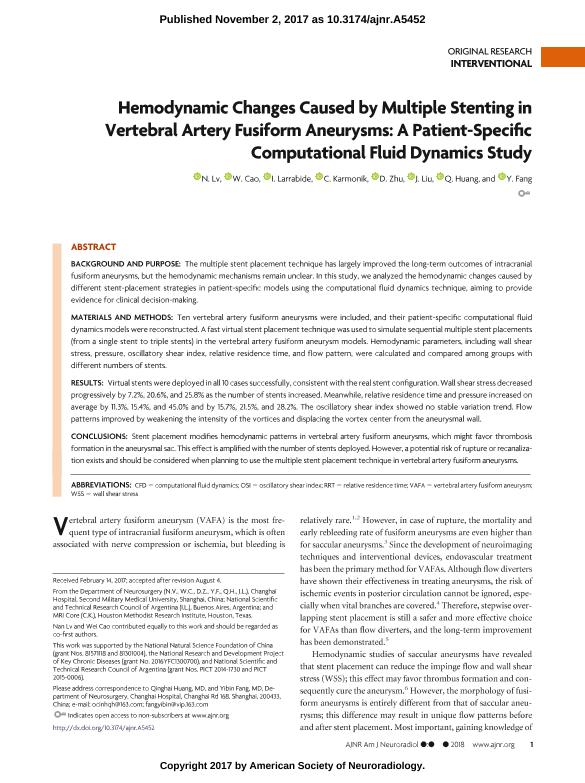Mostrar el registro sencillo del ítem
dc.contributor.author
Lv, N.
dc.contributor.author
Cao, W.
dc.contributor.author
Larrabide, Ignacio

dc.contributor.author
Karmonik, C.
dc.contributor.author
Zhu, D.
dc.contributor.author
Liu, J.
dc.contributor.author
Huang, Q.
dc.contributor.author
Fang, Y.
dc.date.available
2018-08-08T19:02:47Z
dc.date.issued
2018-01
dc.identifier.citation
Lv, N.; Cao, W.; Larrabide, Ignacio; Karmonik, C.; Zhu, D.; et al.; Hemodynamic changes caused by multiple stenting in vertebral artery fusiform aneurysms: A patient-specific computational fluid dynamics study; American Society of Neuroradiology; American Journal Of Neuroradiology; 39; 1; 1-2018; 118-122
dc.identifier.issn
0195-6108
dc.identifier.uri
http://hdl.handle.net/11336/54648
dc.description.abstract
Background and Purpose: The multiple stent placement technique has largely improved the long-term outcomes of intracranial fusiform aneurysms, but the hemodynamic mechanisms remain unclear. In this study, we analyzed the hemodynamic changes caused by different stent-placement strategies in patient-specific models using the computational fluid dynamics technique, aiming to provide evidence for clinical decision-making. MATERIALS AND METHODS: Ten vertebral artery fusiform aneurysms were included, and their patient-specific computational fluid dynamics models were reconstructed. A fast virtual stent placement technique was used to simulate sequential multiple stent placements (from a single stent to triple stents) in the vertebral artery fusiform aneurysm models. Hemodynamic parameters, including wall shear stress, pressure, oscillatory shear index, relative residence time, and flow pattern, were calculated and compared among groups with different numbers of stents. RESULTS: Virtual stents were deployed in all 10 cases successfully, consistent with the real stent configuration. Wall shear stress decreased progressively by 7.2%, 20.6%, and 25.8% as the number of stents increased. Meanwhile, relative residence time and pressure increased on average by 11.3%, 15.4%, and 45.0% and by 15.7%, 21.5%, and 28.2%. The oscillatory shear index showed no stable variation trend. Flow patterns improved by weakening the intensity of the vortices and displacing the vortex center from the aneurysmal wall. CONCLUSIONS: Stent placement modifies hemodynamic patterns in vertebral artery fusiform aneurysms, which might favor thrombosis formation in the aneurysmal sac. This effect is amplified with the number of stents deployed. However, a potential risk of rupture or recanalization exists and should be considered when planning to use the multiple stent placement technique in vertebral artery fusiform aneurysms.
dc.format
application/pdf
dc.language.iso
eng
dc.publisher
American Society of Neuroradiology

dc.rights
info:eu-repo/semantics/openAccess
dc.rights.uri
https://creativecommons.org/licenses/by-nc-sa/2.5/ar/
dc.subject
Aneurismas Cerebrales
dc.subject
Simulación de Fluidos
dc.subject.classification
Otras Biotecnologías de la Salud

dc.subject.classification
Biotecnología de la Salud

dc.subject.classification
CIENCIAS MÉDICAS Y DE LA SALUD

dc.title
Hemodynamic changes caused by multiple stenting in vertebral artery fusiform aneurysms: A patient-specific computational fluid dynamics study
dc.type
info:eu-repo/semantics/article
dc.type
info:ar-repo/semantics/artículo
dc.type
info:eu-repo/semantics/publishedVersion
dc.date.updated
2018-04-16T13:47:05Z
dc.journal.volume
39
dc.journal.number
1
dc.journal.pagination
118-122
dc.journal.pais
Estados Unidos

dc.description.fil
Fil: Lv, N.. Second Military Medical University. Changhai Hospital; China
dc.description.fil
Fil: Cao, W.. Second Military Medical University. Changhai Hospital; China
dc.description.fil
Fil: Larrabide, Ignacio. Consejo Nacional de Investigaciones Científicas y Técnicas; Argentina
dc.description.fil
Fil: Karmonik, C.. Houston Methodist Research Institute; Estados Unidos
dc.description.fil
Fil: Zhu, D.. Second Military Medical University. Changhai Hospital; China
dc.description.fil
Fil: Liu, J.. Second Military Medical University. Changhai Hospital; China
dc.description.fil
Fil: Huang, Q.. Second Military Medical University. Changhai Hospital; China
dc.description.fil
Fil: Fang, Y.. Second Military Medical University. Changhai Hospital; China
dc.journal.title
American Journal Of Neuroradiology

dc.relation.alternativeid
info:eu-repo/semantics/altIdentifier/doi/http://dx.doi.org/10.3174/ajnr.A5452
dc.relation.alternativeid
info:eu-repo/semantics/altIdentifier/url/http://www.ajnr.org/content/39/1/118
Archivos asociados
